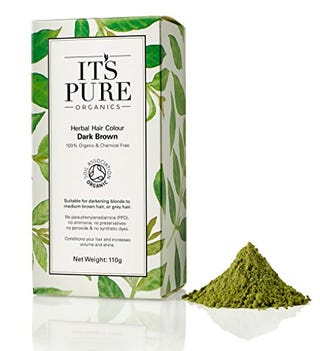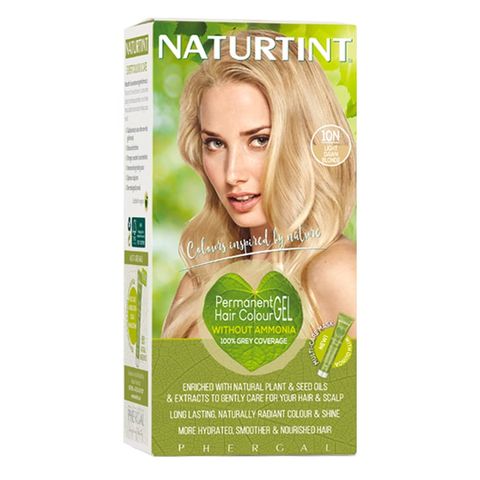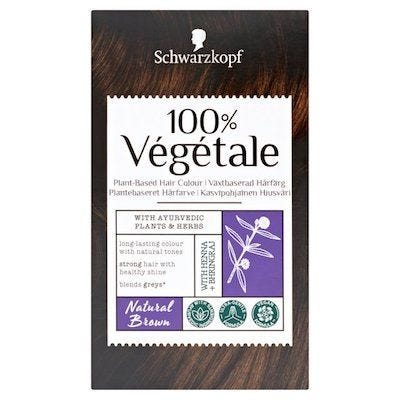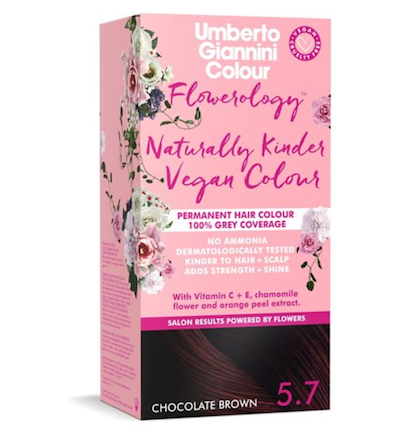How to Darken My Hair Without Dying It
Look: we're going to level with you. Natural hair dyes that provide the same results as your normal DIY colour and contain no synthetic chemicals just don't exist (soz about that).
However, if you are pregnant, vegan or perhaps want to shop more sustainably, seeking out a natural hair dye is a great shout. In fact, there are plenty of henna-based and plant-derived hair colours that can do a stellar job of transforming your locks (more on those later).
But first, here are a few things that your stylist wants you to know about the world of natural hair dye.
What is a natural hair dye?
No longer just a term used to describe plant-based skincare, 'natural' is a word that's weaving its way into colour care. The term is not regulated, though, so best to look out for the ingredients that aren't in there, rather than are. More on that later though.
Do natural hair dyes actually work?
Yes, but a word of warning on semantics. Other than henna, any substance that transforms the shade of your locks permanently probably has synthetic ingredients in its DNA. They may be in lower quantities than traditional products – and, yes, contain no ammonia – but they are likely needed, at some level, for the mix to work.
Another point is that, given that these concoctions tend to be gentler, they might not last quite as long as mainstream dyes. Plus, dramatic colour – think, darker shades going bottle blonde – 'aint going to be happening.
How can I colour my hair naturally?
If you didn't want to reach for a specific brand, there are everyday items you can use to colour your hair. These include:
- Carrot juice
- Beetroot juice
- Henna
- Lemon juice
- Coffee
- Sage
- Chamomile tea
How can I cover my grey hair, naturally?
If you're blonde then it's best to opt for lemon, for darker hair tones try henna.
Should I use a natural hair dye?
Firstly, if you deal with dry hair, then a plant-based product could help. 'Most traditional hair colours use ammonia, resorcinol, paraphenylenediamine (PPD) and para-toluenediamine (PTD),' says Olivia Crighton, hairstylist and director of Glasshouse Salon. 'These [ingredients] can raise the PH level of your hair beyond normal and the ammonia can damage your hair condition.' But that's not all.
Traditional hair dyes are known to degrade the protein in your hair, while also wicking away moisture, explains Crighton. 'This prevents the cuticle from effectively closing, which could result in lacklustre hair that can appear dull, has reduced colour retention and you may find your colour fade quicker.'
In addition, ammonia (what gives hair dye that pongy smell) and resorcinol, a common colour pigment, are highly toxic in nature. In the past, studies have linked these chemicals to skin and eye irritations and in extreme cases respiratory problems.
'Finally, paraphenylenediamine (PPD) and para-toluenediamine (PTD) are petroleum derivatives,' and are ingredients to be wary of warns Crighton. 'Permanent hair colour often uses high percentages of these ingredients which irritate sensitive skin types.'
6 things you need to know before using natural hair dye
1. Do think about how you wash and care for your hair
Certain ingredients in shampoos and conditioners can affect how well natural hair dye takes to your hair.
'You don't want to use a silicone shampoo,' says Eric Bone, International Director Sustainable Innovation, Hair Metiers, L'Oréal Research and Innovation. 'Silicon shampoos are heavy so will prevent the colour from grabbing onto your hair.'
Silicones also create an artificial barrier around your hair strands and can inhibit colour absorption. Stick with natural shampoos and biodegradable products, to make the most out of your hair colour.
'They are very gentle to the hair fibre,' says Bone, 'so would be a good complement [to the colour] to take care of your hair.'
2. Don't be afraid to ask for advice
Again, consulting a professional stylist can leave you with better colour results. Though there are natural dyes on the market, they all work differently depending on your hair colour - so while they may work great on blondes, darker colours might not get results.
The condition of your hair could also make a big difference to how well colour grips to your locks. But if you think you can't a get a natural colour because of your frizzy roots or dried out ends, think again.
'With any product that you put on your hair it will depend on the state of your hair and whether it is damaged or not,' says Bone. 'If you have very thick hair for example, the uptake of the colour will be a bit more difficult compared to hair that is already slightly damaged - that will be easier.' Who knew?
3. Know that you can just use a tint
Some natural shampoos and conditioners will tint your natural hair colour or previously dyed hair. So you can have a colour refresh with no need for a harmful dye. Try Aveda's pure plant range that uses madder root and black Malva to add different hues to your hair.

Aveda Color Enhance Madder Root Shampoo 1000ml
Aveda feelunique.com
£46.50
4. Do look for natural ingredients
Yep, not just the grated hero of lunchtime salads, beetroot's colour pigments can actually be used to dye your hair.
'Many brands are now introducing ingredients such as beetroot and henna as an alternative to chemical dyes,' says Francesca Dixon, Hari's Hairdressers' Senior Creative Colourist.
'Be aware that some of these are more colour enhancers than dyes,' says Dixon. 'You can still achieve a great overall colour, however they do not penetrate the cortex of the hair, so many not be as permanent as a chemical dye.'
Newer natural hair dye formulas also use specially sourced Asian powders to dye the hair. Cassia powder, henna powder, indigo leaf powder, alma powder and neem powder can all be combined in various ways to make pastes that change your hair colour.
And if previously hair dyes required 3 hours processing time, these powders that can naturally lightens hair in 30 minutes to an hour. However, while you can be out of the salon in an hour, be wary of harsh chemicals for two days afterwards as the colour will take time to settle.
'If you go for darker shades where you have a bigger concentration of indigo natural dye, you would go through a process where the full development of colour would take several hours,' says Bone.
'It could be up to 48 hours, which is why we say that for the darker shades you have a full development of colour. That does not mean you can't wash your hair in that time though, because the dye particles are already into your hair and they are being oxidised to give the final colour through the hair oxidation.'
Handy. Look out for lemon juice too, as this can have a bleaching effect to lighten your locks, and turmeric, which can enhance blonde shades. So while that golden latte may stain your coffee mug, it could give you the beach-y highlights you're looking for.
5. Do check the pH level of your products
Healthy hair will have a pH between 4.5 and 5.5, meaning that your hair cuticles will be closed, keeping hair hydrated and maintaining elasticity. Try and find conditioning products that are more alkaline, as this will balance out the high pH of the colour.
'[Natural hair dye] is designed to work within the hair's optimum pH levels,' says Karine Jackson, Karine Jackson Hair & Beauty. "The base of the colour is already alkaline to raise the pH, whilst also being a conditioning agent to soften the cuticles. This softening process means that Organic Colour Systems is able to work at a far lower pH, which is gentler on the hair and far less ethanolamine (a chemical that contributes to dry ends and colour fading) is required.'
6. You can always go pro
It's worth noting that while there are some good short-term natural, hair dyes for home use, if you want long-lasting colour, it's best to head to a salon.
'We use Organic Colour Systems' hair colour,' says Crighton. 'It contains a fraction of the amount [of PPD and PTD] in comparison to traditional dyes. The absence of ammonia also ensures we minimise pigment absorption into the bloodstream as we are not opening the pores of the skin in the same way as a traditional colour might.
'It's worth noting there are good semi-permanent (non oxidative dye) options around (ie. No Limits by Organic Colour Systems, used in salons) that don't contain these pigments for those too sensitive. Semi-permanent colours will not be able to lighten the hair though and have minimal grey coverage as they work on the outside of the hair.'
Crighton's thinking aligns with other new launches you'll soon see in a salon near you. Take, L'Oréal Professionnel Botanéa – the newest herbal hair colour launch. Using a trio of powder pigments and water heated to a precise temperature your colourist can re-vamp your hair colour sans chemicals sans high heat. But precision is key here. Both the mixture and the temperature measurements need to be spot on to avoid a hair mare.
What is the best natural hair dye?
1. It's Pure Organics Herbal Hair Colour Dark Brown
Certified Organic by the Soil Association, this is henna-based. It's free of para-phenylenediamine (PDD), ammonia, peroxide and parabens, and can be used to darken greys, as well as medium brown or blonder hair.

Organic Hair Dye - It's Pure Organics Herbal Hair Colour Dark Brown
2. Christophe Robin Temporary Colour Gel
If you need a root touch-up between salon dyes, then this formula, free from ammonia, peroxide, oxidants, resorcinol, PPD, silicones and SLS, is a god-send.

Christophe Robin Temporary Color Gel - Dark Blonde 100ml
Christophe Robin lookfantastic.com
£30.00
3. Herbatint 4N Chestnut Permanent Herbal Hair Colour
A plant extract-based dye that nixes grey roots on dark shades.

Herbatint 4N Chestnut Permanent Herbal Hair Colour Gel 150 mililitre
4. Saach Organics Natural Hair Colour
Minus para-phenylenediamine, ammonia, peroxides. This can cover greys, but will not lighten your hair.

Saach Organics Natural Hair Colour (Light Brown)
saach organics Amazon
£10.95
5. Naturtint Permanent Hair Colour
Without ammonia but definitely with other synthetic chemicals. A halfway house, if you will.

Naturtint Permanent Hair Colour 10N (Light Dawn Blonde)
hollandandbarrett.com
£10.99
6. Lush Henna Hair Colour
This henna block is a little messy to use, but it's totally worth it given the rich colour it leaves behind. Made with conditioning properties it also offers a mirror-like shine.

7. Schwarzkopf 100% Vegetal Natural Brown Vegan Hair Dye
As well as dose of henna, this formula also contains "fairy daisy", which thanks to its delicate white flower offers caring and conditioning qualities, making it a good choice for dry or delicate ends.

Schwarzkopf 100% Vegetal Natural Brown Vegan Hair Dye
schwarzkopf ocado.com
£9.99
8. Umberto Giannini Flowerology Vegan Colour Chocolate Brown 5.7
With Vitamins C + E, chamomile flower and orange peel extract, this formula containd
pigments that reflect the light, add shine and cover greys.

Umberto Giannini Flowerology Vegan Colour Chocolate Brown 5.7
umberto giannini boots.com
£6.67
9. Clairol Natural Instincts Vegan No Ammonia No Parabens Semi-Permanent Hair Dye 2 Black
Lasting up to 28 washes, you can rely on this hair colour to enhance your natural shade.

nice n easy Clairol
nice n easy boots.com
£6.99
10. Bio Organic Triple Sifted Microfine Powder Henna Hair in Copper
This triple sifted microfine powder ensures hair gets an even coating of colour. It's also 100% free from pesticides, chemicals and additives.

Henna Hair Dye 100% Bio Organic Triple Sifted Microfine Powder (Copper)
INDUS VALLEY amazon.co.uk
US$7.99
Cut through the noise and get practical, expert advice, home workouts, easy nutrition and more direct to your inbox. Sign up to the WOMEN'S HEALTH NEWSLETTER.
This content is created and maintained by a third party, and imported onto this page to help users provide their email addresses. You may be able to find more information about this and similar content at piano.io
How to Darken My Hair Without Dying It
Source: https://www.womenshealthmag.com/uk/beauty/hair/a708157/natural-hair-dye/
0 Response to "How to Darken My Hair Without Dying It"
Post a Comment